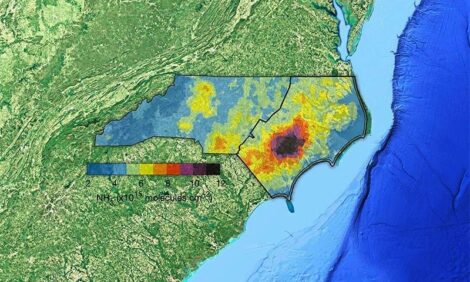



Measurement of Acute Phase Proteins
The measurement of Acute Phase proteins in oral fluid to help assess sub-clinical disease in pigs is one of the new tools developed to improve disease monitoring, according to BPEX in No. 13 of its 'Research into Action' series.Poor health negatively impacts performance parameters of finishing pigs, reducing feed efficiency and daily live weight gain, increasing weight variability, veterinary treatment costs and mortality. Clinical and sub-clinical stages of disease both produce substantial compromising effects to growing herd performance, and in tackling disease problems, both should be addressed for effective control.

Work at Newcastle University researched provision of
between one and four ropes to pens of pigs in fully slatted and straw-bedded
systems to explore how the representative quality of
the oral fluid sample could be optimised. The results
demonstrated that for groups of up to 25 pigs, provision
of one or two ropes for 45 minutes is sufficient to optimise
collection of a pooled oral fluid sample from the pen.
Of particular relevance to UK pig production, when
sampling oral fluid from straw bedded pens, a lower
percentage of the pen group chewed the rope (15 per cent
fewer pigs at 45 minutes presentation), and increasing the
number of ropes had no effect on improving uptake.
A further study at Newcastle University then applied the use
of pooled pen oral fluid samples to examine concentrations
of acute phase proteins (APPs) in groups of finishing pigs as
a possible marker of sub-clinical disease in pigs.
- An increasing number of swine pathogens and relevant antibodies are now able to be detected in pooled oral fluid samples
- The use of a pooled oral fluid sample for disease surveillance was developed by researchers at Iowa State University
- Sample collection is performed by suspending a cotton rope over a pen for pigs to chew and deposit oral fluid
- The technique offers a low cost, non-invasive method of sample collection from groups of pigs, providing a viable method for regular disease surveillance to take place on farms.
Trial Details
- A total of 80 finishing pigs were monitored from point of entry to a finishing building (53kg) until slaughter
- The pigs were housed in a continuous flow finisher building where sub-clinical disease was thought to be contributing to sub-optimal growth
- Symptoms of disease and treatments administered were recorded daily, cough, diarrhoea (scour) and sneeze scores weekly, pig weights and feed intake every two weeks and lung and stomach pathology scores from all pigs at slaughter
- As the oldest pen group reached market weight (76kg), paired blood serum and oral fluid samples were collected from all pigs and analysed for concentrations of two APPs, Haptoglobin (Hp: a protein that increases in concentration in response to a wide variety of acute and chronic immune activation) and C-reactive protein (CRP: a protein that increases in concentration under acute inflammatory conditions)
- A pooled oral fluid sample was also collected per pen of pigs
- The paired samples were also analysed for antibodies and viremia levels of Porcine Reproductive and Respiratory Syndrome virus (PRRSv), known to be present at the study farm.
| APPs are a group of immune components that alter in concentration in response to disease. As one of
the first immune responses to disease, they offer a potential diagnostic indicator of sub-clinical disease.
The magnitude and duration of the APP response reflects the activation of the immune system, therefore providing a possible indicator of growth losses as a result of immune activation in pigs. |
Trial Results
- The growth rate of the pigs was sub-optimal at 0.65kg per day, although there were few clinical signs of disease over the study (Table 1)
| Table 1. Productivity and health ailments* of all pigs studied (n=80, pen mean and range) | |||||||
|---|---|---|---|---|---|---|---|
| Finisher ADG (kg) |
FCR | Total pigs seen coughing | Cough score | Lung score | Scour score | Stomach score | |
| Mean | 0.65 | 3.31 | 0.05 | 1.50 | 3.30 | 1.32 | 3.45 |
| Range | 0.59–0.72 | 2.51–3.93 | 0–2 | 0–4.5 | 0.9–6.5 | 1–1.8 | 2.6–4.1 |
| * Cough score: total number of pigs observed coughing within five minutes of observation. Scour score (faeces 1–4): 1=firm, 2=soft, spreads slightly, 3=spreads readily; 4=water like. Lung score: lobes of lungs graded for area affected by disease on 55 point scale. Stomach score (pars oesophagea region 0–5): 0=normal, 1=parakeratosis beginning, 2=slight parakeratosis, 3=moderate parakeratosis, 4=severe parakeratosis, 5=ulcer. |
|||||||
The concentration of APPs in blood serum
correlated to the levels in oral fluid, indicating the
use of oral fluid for APP testing is a feasible
non-invasive method.
Investigation of predictive factors that were
related to the concentrations of APPs in individual
pigs revealed that the duration of time the pigs
had been housed in the continuous-flow finisher
building was related to the concentrations of the
APPs, demonstrating that pigs were experiencing
infectious challenge upon entering the building.
The average daily gain in the finisher period negatively
related to the concentration of oral fluid CRP, whilst
the lifetime growth performance of the pigs was
negatively related to the concentration of oral fluid
Hp detected, providing evidence that the pigs were
experiencing growth depression as a result of immune
activation at this time.
The concentration of CRP from pooled oral fluid
samples collected from each pen was positively
correlated to the pen average gain per day.
Application
Whilst research is continuing to improve detection and
sensitivity of different swine pathogens in oral fluid, in the future
the use of pooled oral fluid samples could offer a low
cost option for disease surveillance. This would prove very
useful for regular sampling that may be required to establish
disease circulation patterns within a unit. The sample
collection would also be able to be performed by stock people,
removing the risk of disease transmission between farms.
The measurement of APPs in oral fluid could provide a
convenient, low stress method to objectively assess the level
of immune activation associated with sub-clinical disease that
could be contributing to sub-optimal growth in pigs.
This study provides initial evidence that there is potential for
the use of a pooled oral fluid sample to assess APPs, which
would greatly reduce diagnostic costs. Further work should
be conducted to explore this area. Work to assign the degree
of lost production relative to a change immune activation in
APP concentrations is a necessary further step to enable this
technology to be put to use for industry. In the long term, the
use of APP measurement could also provide a tool to
benchmark herds in terms of health status and performance.
References
Ramirez, A., Wang, C., Prickett. J.R., Pogranichniy, R., Yoon, K-J., Main, R., Johnson, J.K., Rademacher, C., Hoogland, M., Hoffmann, P., Kurtz, A., Kurtz, E. and Zimmerman, J. (2012) Efficient surveillance of pig populations using oral fluids. Preventative Veterinary Medicine, 104 (3-4):292-300.
Further ReadingFind out more information on Porcine Reproductive Respiratory Syndrome (PRRS) by clicking here. |
November 2012







